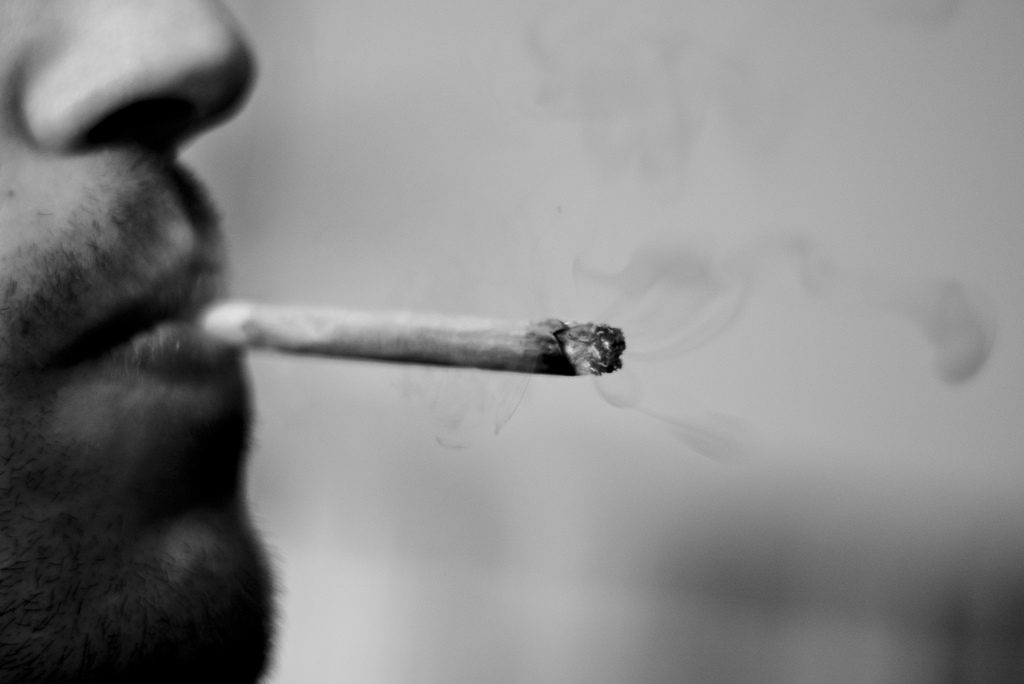Loyal readers will remember that we examined The Times journalist Alice Thomson’s claims about Colorado’s experience of recreational cannabis legalisation back in 2016—and they were found wanting. Fast forward to 2019 and nothing has changed, with Thomson penning an article in The Times yesterday arguing that the backlash against cannabis culture has begun: citing arguments from former New York Times reporter Alex Berenson’s new book Tell Your Children: The Truth About Marijuana, Mental Illness, and Violence.
Of course, the past century of cannabis criminalisation and moral panic across the globe has been one long “backlash against cannabis culture”. Berenson’s book is the latest instalment in this long tradition, albeit from an ostensibly liberal perspective. His argument? “Marijuana causes psychosis. Psychosis causes violence. The obvious implication is that marijuana causes violence.” Much like their predecessors, Berenson and Thomson misrepresent the weight of evidence. But serious critical engagement in the legalisation debate is always welcome, so, without further ado, let’s dive in…
“Nic is a clever, kind, athletic 12-year-old when his father finds marijuana in his backpack. By the age of 18 he has moved on to crystal meth and heroin. He steals from everyone, including his little brother’s piggybank, he prostitutes himself, lives in a park, overdoses, nearly has his arm amputated after an infection and almost dies from a cocaine overdose…the one trait [mentally ill criminals] had in common was that they had all smoked pot…Richard Kirk, who shot his wife while in a psychotic state after eating marijuana candy to alleviate back pain…”
Though they make for harrowing reading, these anecdotes give no reason to suggest that cannabis use causes violence. I’m sure both Thomson and Berenson would both agree with this, but it’s worth making crystal clear. That was an easy one!
“The first four states to legalise marijuana for recreational use were Alaska, Colorado, Oregon and Washington. All have seen an increase in murders and aggravated assaults since 2014, with police reports showing in many cases a clear link to cannabis use.”
There’s nothing revealing about this observation either. An increasing rate of murder and aggravated assault post-legalisation is better evidence than anecdotes, but still doesn’t cut the mustard. Correlation does not by itself imply causation, even if (as Berenson does) you compare trends to the national average. If it did, one could point to Oregon’s murder rate dropping by 11.6% in 2016-17 (ten percentage points more than the US average) as evidence that cannabis legalisation strongly depresses murder rates. Or simply point out that besides aggravated assault in Colorado, Berenson’s increased violent crime rates aren’t far off the national trend.
But any pro-legalisation advocate worth their salt won’t do this, because it’s a shoddy argument for any position. Serious analysis would compare post-legalisation U.S. states to their counterfactual no-legalisation counterparts (based on a weighted average of states that closely follow their crime trends) and examine their violent crime rates. When Professor Benjamin Hansen from the University of Oregon did just that, he found that “the homicide rates in Colorado and Washington were actually below what the data predicted they would have been.” Berenson has since criticised some of Hansen’s data and comparison group choices, which Hansen has duly responded to finding similar or null results. After further exchanges, Berenson is now “done debating the fake state model” but Hansen’s work remains credible. So a more robust approach suggests that cannabis legalisation doesn’t seem to have a significant effect on violent crime rates.
Other high-quality research suggests that cannabis retail dispensaries lead to reduced crime in the neighborhoods where they are located and medical marijuana legalisation alone reduced the violent crime rate in Mexican-border states by between 5.6% and 12.5%. There’s plenty more evidence that the link between liberalising cannabis laws and violence is not what Berenson claims. He appears to want to have his cake and eat it—we can’t be sure whether legalisation has caused more violent crime, but we can apparently be sure that it hasn’t.
“The cannabis being bought, [Berenson] suggests, is far more potent now. In the 1970s and 1980s when his generation was smoking, most marijuana contained less than 2 per cent of THC, the chemical responsible for its psychoactive effects. Today, it routinely contains 20 to 25 per cent THC. It’s the difference between a sip of beer and a tequila shot.”
Cannabis does indeed appear to be increasing in strength in the U.S, UK, and Europe: it has been for decades. There are a number of factors driving this increase, but prohibition is certainly among them. Criminal penalties give suppliers an incentive to grow less cannabis while delivering the same experience for users; if you have lower amounts of cannabis to hide or transport, you’re less likely to get caught. This was part of the reason that high-strength alcohol dominated Prohibition-Era drinking culture: people drank beer before, moonshine during, and beer after.
To what extent has this translated into higher overall levels of THC consumption? It’s still an open question; research from the Netherlands has found that cannabis users with a preference for stronger joints adjust their THC intake by inhaling less smoke, though not at a level that fully compensates. If policymakers want to shift cannabis users onto lower-strength products, legalisation provides the opportunity for a graduated tax on THC levels: set at levels that compete with the black market. It would also allow governments to mandate minimum levels of CBD, which research suggests may protect against adverse psychological effects from THC intake. As we put it in our 2016 report The Tide Effect:
“Regulation would allow for both the THC and CBD content of cannabis products to be quantified, quality controlled and clearly communicated to consumers, provided alongside extensive and comprehensive health information [as it is in Canada] which could then be built on by wider and deeper medical research. ”
Such measures are based on a reasonable application of the precautionary principle, but the question of whether and to what extent cannabis use causes schizophrenia and other psychoses is far from settled. And yet…
“The US National Academy of Medicine reported that “cannabis use is likely to increase the risk of developing schizophrenia and other psychoses; the higher the use, the greater the risk”.”
At first read, this passage from the National Academies report—a comprehensive review of scientific evidence on the health effects of cannabis—seems like a big problem for pro-legalisation advocates. We know that recreational legalisation leads to a modest increase in overall use of cannabis and it would therefore follow that it will lead to increased incidence of psychoses. Ergo, legalisation is a disaster.
Not so fast. Firstly, the above excerpt needs to be viewed in the context of the report. As one of its authors has pointed out, “we did NOT conclude that cannabis causes schizophrenia.” This does seem to be stretching things somewhat; it’s hard to argue that saying “cannabis use is likely to increase the risk of developing schizophrenia and other psychoses” is not a claim about causality. But the rest of the chapter in question makes no such claims about causality, instead focusing solely on the moderate to strong association between cannabis use and psychoses (interestingly, the report also found an association between cannabis use and improved cognitive outcomes in individuals with psychotic disorders). Once again, correlation does not necessarily equal causation and like the ‘cannabis cures cancer’ crowd Berenson massively overstates his case. As Vox’s German Lopez puts it:
“Maybe psychosis or psychotic disorders lead to marijuana use, or a third factor — say, genes or environment — leads to psychosis and marijuana use. It could be a mix of all these factors. The conclusion [of the report], if there is one: “This is a complex issue, one that certainly warrants further investigation.” In other words, we don’t know yet.”’
Secondly, increased overall use under legalisation is a crude metric of harm caused by cannabis use. It’s also important to focus on changing patterns of use: especially if, as is often stated, the mental health effects of cannabis vary by the age of users. The old pro-legalisation adage that “drug dealers don’t ask for ID” is backed up by hard evidence; teen marijuana use falls or remains the same after legalisation.
Thirdly, and most importantly, increased overall use is a terrible measure of the harm caused by different approaches to drug policy. Berenson and Thomson are both guilty of downplaying or outright ignoring key arguments in favour of legalisation, instead only focusing on the debate around mental health effects of cannabis use. Yesterday morning, arch-prohibitionist Peter Hitchens started a petition “for an inquiry into the correlation between marijuana use, mental illness and violence.” I’d support this as well, but it should be part of a Royal Commission examining the wider costs and benefits of changing our approach.
Consider the worst-case scenario: cannabis turns out to cause psychosis and a regulated market with measures to prevent youth use, educate consumers, and shift consumption to safer cannabis fails to achieve these aims. We’d need to weigh up the hypothetical harm caused by cannabis-induced mental illness and its consequences against the very real harm currently caused by criminalisation, from labour trafficking and child exploitation to gang violence and (as Berenson mentions) the real ‘gateway effect’ of drug dealers selling more harmful drugs alongside cannabis. We’d need to consider the fact that criminal convictions for possession of a class B drug can ruin someone’s life chances, hurt employment opportunities, and damage their mental health. We’d need to examine how cannabis users substituting for powerful synthetic cannabinoids (children of prohibition) such as Spice may lead to more mental health harms. We’d need to factor in substitution effects between cannabis and alcohol. And we should also remember the fact that cannabis is, for the overwhelming majority of its users, an enjoyable consumer product: one that causes less harm than many existing legal products that nobody sane thinks we should make illegal.
Our approach to cannabis is at a crossroads. One option is to double-down on prohibition and fully enforce our current laws: which Peter Hitchens happily admits are “in some ways tougher than Singapore’s” on paper. Or we could go back to the drawing board and agree on a set of goals – minimise underage use, do as best for people with mental health problems as possible, minimise crime, and make sure that if people do smoke cannabis it’s safe – and work out the system that gives us that.
Rather than rubbishing recreational legalisation, commentators like Thomson should look again at the evidence. The best alternative to our failed approach is legalising and regulating cannabis for recreational use, which will take back control of the unregulated market from criminals, protect children from exploitation, free up police time to focus on violent crime, shift current users towards safer consumption patterns, and let adults make free, informed decisions about their lives. We’ll be making that case at length in a research paper this year, so stay tuned.
Daniel Pryor is Head of Programmes at the Adam Smith Institute. Tweets @DanielPryorr


